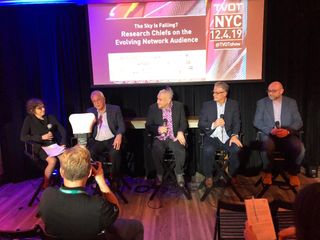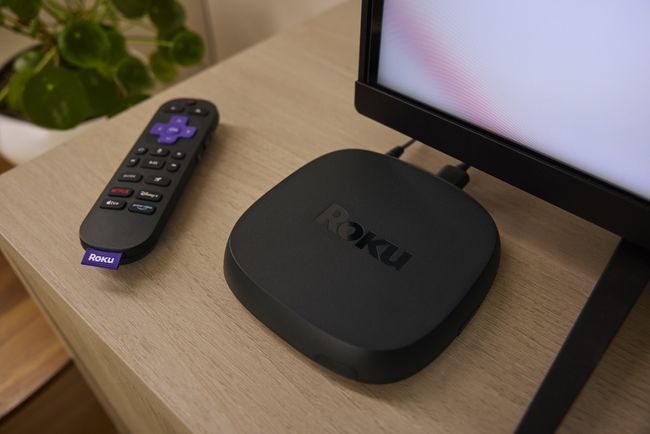Surviving OTT: Research Chiefs TVOT Opine Changing Landscape
To stay afloat, linear broadcasters are broadening their scope to OTT
“If I dug a hole every time somebody said TV was dead, I would be in China by now,” Helen Katz, senior VP of Global Contracts and Data Partnerships at Publicis Group, said while moderating a panel at the Dec. 4 TV of Tomorrow conference in New York. The panel theme: “The Sky is Falling? Research Chiefs on the Evolving Network Audience.”
One look at the five broadcast networks’ average primetime audience this season – 30.78 million viewers through Nov. 30, according to Nielsen – and the logical assumption should be the combined platforms of ABC, CBS, NBC, Fox and The CW, overall, are still healthy.
That figure is actually down by 1.7 million viewers (or 5%) year to year, though, and down 11% in adults 18-49 (a 6.7 rating versus a 7.5 in 2018).
Still, that audience is a long way from TV death, or from being replaced by largely unmeasured over-the-top programmers.
But how the audience consumes content is evolving, as more eyeballs migrate to non-traditional platforms like streaming or cut the cord altogether.
To stay afloat, and remain relevant, linear broadcasters are broadening their scope to OTT, hoping to expand the audience reach for advertisers while retaining as many of the traditional viewers as possible.
Of course, that brings up some questions. To what extent is viewing of network content shifting from traditional linear television to new devices and services in this growing digital world? Just how do you measure the shift? What other data sources are you relying on? And what does this mean for advertisers?
NEXT TV NEWSLETTER
The smarter way to stay on top of the streaming and OTT industry. Sign up below.

Television is Still the Term
“The term ‘TV is dying’ does not apply to any of us here,” Julian Zilderbrand, executive VP of Audience Science at Viacom, said. “But for us specifically we are seeing a lot of our IT [digital] consumption happening at the TV-plus place,” meaning outside of linear viewing, “which has enabled us to create other addressable products and things of that nature that allow us to gather a host of information. We can see that there is still a wide audience that is still consuming content.”
“We are using so many more data sources than when I started in this field in the mid 80s, early 90s,” Tom Ziangas, senior VP of Research at AMC Networks, said. “The data sources we’re utilizing, whether it’s set top box data or smart TV data, or other metrics like TVision or 605, is probably 10 or 20 times more data points than we have ever dealt with. From that perspective, we need to work differently as a research department.”
TVision is a TV marketing technology firm that delivers real-time performance metrics for advertising effectiveness and efficiency. 605 is an independent TV measurement firm that also offers advertising and content measurement.
“We talk about content, but as researchers context is king,” Ziangas said. “I know a lot of what is going on in my five networks. I just don’t know what is going on in the other 150 plus networks.”
“There should be an amalgamated data set that reflects delivery everywhere that is supplied by the folks responsible for it,” Jonathan Steuer, chief research officer at Omnicom Media Group, said. “If we don’t have a common reference data set that’s been cleaned up and weighted in a coherent manner, it is really difficult, then, to have the same buying and selling conversations across the marketplace.”
“I think we are a long way from that today,” added Steuer. “But it is in our power to hopefully move in that direction.”
David Ernst, VP of Advanced TV and Digital Insights at A+E Networks, pointed to the additional benchmarks to consider when evaluating the success, or lack of, for any television series.
“We are used to looking at a small number of demographic buckets,” he said. “And with all the different ways people can watch all the different stuff, putting the tools together to try to understand the complexity of different viewership archetypes is the challenge. We just did a big study about streaming and from that alone we came up with four or five different ways of people using streaming. You must consider all these non-traditional areas.”
The Future for Advertisers
“Just five or so years ago, there were really only a few advertisers that were heavily investing in the non-linear space,” Steuer said. “Now, today, you can hardly find a brand that is not investing across the board. Every advertiser must do that now, but they also need the metrics to support what brings the most value.”
“I think linear television is going to have to go beyond its core advertisers, the 500 or so that [data firm] SMI [Standard Media Index] recently showed in a chart, and it needs to start featuring those brands that have also resonated digitally,” AMC’s Ziangas said. “And those digital brands need to expand as well to linear.”
“Of course, the bottom line is still the content,” Ziangas said. “It is about being able to provide high quality content to consumers, being able to reach those consumers via the plethora of advertisers, and helping to drive those sales for them.”
Marc Berman is editor-in-chief for media-centric The Programming Insider (programminginsider.com), which pioneered the email newsletter format at its inception in 1999. Marc has written for a wide range of publications including Broadcasting + Cable, Next TV, Forbes, Newspro, Campaign US, The Hollywood Reporter and Variety. Known as “Mr. Television” at Mediaweek (now Adweek), Marc has appeared on camera on Entertainment Tonight, Extra, Inside Edition and CNN and MSNBC, among other series and outlets. He is a member of The Television Critics Association and The Broadcast Journalists Television Association. And Marc put his TV historian hat on as author of desk calendar Today in TV History.











